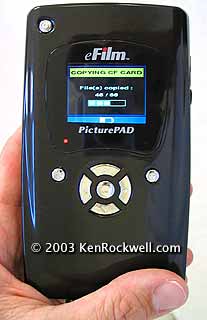Home Search Gallery How-To Books Links Workshops About Contact
Delkin
Picture PAD Test Review
get it here 20GB 30GB 40GB 60GB INTRODUCTION This gizmo is a battery powered hard drive with a card reader and teeny weeny screen on it that costs about $500. You use it to store your digital photos until you have the ability to load them into a real computer. SPECIFICATIONS Delkin's lit says it comes in 20GB and 30GB versions, either of which seem to sell for about $500 so I'm unsure why you'd want the 20GB version. Then again, Adorama lists 20GB, 30GB, 40GB, and 60GB versions, most of which cost about the same. I'll presume Delkin's website and lit are out of date. It runs on a lithium-ion rechargeable battery, a nice touch, but Delkin still only rates it as running for an hour on a charge. Heck, my Canon A70 camera runs 4 or 5 hours on a charge. Supposedly the Picture PAD allows about 2GB of transfer from cards till you need to recharge it. That means 2 transfers from 1GB microdrives, 4 from full 512MB cards or 30 from 64MB cards, etc. I'm unsure if you can load only what's new from a card or if you have to download the entire card. I think you have to download the whole card, which would make this device pretty useless. The tiny screen is 320 x 240 pixels. It won't play movie files. PERFORMANCE It feels like a small rat is wandering around inside the device as the hard drive spins up or down. Not that this is bad; it just lets you know something is happening. The screen is teeny. The zoom mode is useless; all it did was make huge pixels without giving any detail which would be useful for knowing which images to keep. It seems reasonably easy to figure out how to use. A huge concern with just the few minutes I played with it that I didn't see any way to download just the newer images on a card. This would make it useless, since you'd have to download a whole card each time you used it. I did not try to get the images out of it onto my computer. This of course is the whole point of this device. It did show a histogram, however it was marked "luminosity" which is useless since problems with exposure in any one of the R, G or B channels ruins an image and will not show on a luminosity histogram. I didn't easily see a way to get a far more useful composite RGB histogram. The display itself is smaller than most digital cameras and offers fewer features (like no ability to play movie files) so there's no reason you'd want to show images to others on this. I see little to no ability to organize and move files around easily. You have to do everything with just a few buttons, not a full keyboard or mouse. Because you are essentially playing a video game with just a few buttons you really can't do much with this device, lacking a real keyboard and mouse. I doubt you could rename files or sort them into new folders with useful names, for instance. RECOMMENDATIONS I see no point in this device, so I didn't spend much time with it. It offers almost no utility and costs almost as much as a laptop computer. For instance, you can get a fully featured professional laptop like the tiny, lightweight (magnesium frame), durable (rubber mounted hard drive) and durable (case made of the same polycarbonate as my motorcycle helmet) Apple 12" G4 iBook for about $1,099 as of March 2004. Unlike the overpriced poo from Dell and Compaq and Sony Vaio and HP, this $1,099 laptop is a full featured professional imaging workstation with Firewire ports and 24x CD burners. Likewise avoid the stripped down PCs that compete against this professional Apple at the same price. Add a $25 card reader and you are all set. See my page on Downloading in the Field for more suggestions. On the other hand, if your interest in this product is for backup while on the road, it costs less and works much better just to buy an external USB or FireWire hard drive and use it along with your laptop. This way you have full functionality for editing and viewing and everything. For example, a 40GB LaCie drive sells here for just $172, and it requires NO separate batteries or anything. You just plug it into your laptop and it's treated just like another hard drive. The Picture PAD is intended for people running off into the boonies for extended periods who need a place to download their photos so they can reuse their cards. If I'm away that long I bring a laptop so I can actually do something with the images, as well as actually see them. With a laptop you can do everything you want. With the Picture PAD you are crippled and really can't do much of anything since it has no keyboard or full size screen or anything People ask me why I test some things and not others. Easy: I test what I use. In this case a friend wanted me to check it out, I did, and post here my quick impressions. |



